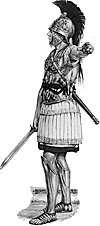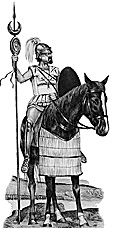Hannibal had been taking the war to Italy for almost two years. In the summer of 216
BC Hannibal mover from Gerunium with 40,000 infantry & 10,000 cavalry and marched south east to to Aufidus (Ofanto) river and onto Cannae. After assembling the largest Roman army ever the Roman consuls, Caius Tarentius Varro and Lucius Aemilius Paullus, moved to confront the
Carthaginians with approximately 80,000 infantry and 6,000 cavalry (8 legions and allies, but understrength in cavalry).
In response Hannibal offered battle on the north bank of the river which
gave him plenty of space for his cavalry to operate in. The Romans refused battle, but
on the following day they deployed south of the river, with their right anchored on the
river and their left covered by foothills. Hannibal, eager to come to grips with his
enemy crossed over and formed for battle, his deployment covered by a screen of light
troops.
The Romans formed up with the Roman cavalry (approx. 1,500) on the right flank (anchored by the river) and the Italian allied cavalry (approx. 4,500) on the left. The infantry was in the centre, formed in much greater depth and density than normal. The Roman plan was to win the battle by battering through the Carthaginian centre with their very dense infantry formation.
Varro commanded the left and Paullus the right (an arrangement which suggests that Paullus may have been in command that day, although the sources indicate it was Varro). The two proconsuls, Marcus Atilius Regulus and Servilius Geminus commanded the centre.
The Romans also left 5,000 men to guard the camps and a further 10,000 were detached and held in the larger camp in order to attack the Carthaginian camp.
Hannibal deployed his Spanish and Gallic infantry in the centre (approx. 30,000) in a
crescent shaped line with the centre extending towards the Roman position. On each side of this battleline were about 4,000 African heavy infantry held in reserve. On the left flank were the Gallic and Spanish cavalry (approx. 6,000) and on the right the light Numidian horse (approx.
4,000).
The Battle Opens
The battle opened with the screens of light infantry skirmishing and the opposing cavalry wings becoming engaged. On the Roman left the Allied cavalry failed to close with the Numidians and became tied with their enemies's skirmishing tactics. On the Roman right the Roman cavalry was charged by the Gallic and Numidian cavalry.
Meanwhile the Roman infantry charged the centre of Hannibal's battleline, forcing it back. As the densely packed legionaries advanced the Carthaginian crescent formation became flattened (there is no mention of Carthaginian troops breaking under the pressure of the Roman advance
so it's possible they may have deliberately 'given ground for time' and were aiming to delay the enemy advance). The legionaries advanced inexorably, even as Hasdrubal's cavalry hit the rear of the Allied Italian horse, driving it from the field pursued by the Numidians.
By now the Carthaginian battleline was starting to bend backwards from the centre under the pressure of the Roman infantry. The African infantry advanced from reserve, anchoring the flanks of the bending Carthaginian infantry line and wheeling in against the exposed flanks of the Roman foot as the Roman centre continued to push forward.
The outermost Roman formations fell into disorder under this pressure. Hasdrubal, having regrouped his cavalry once more, charged the rear of the massive Roman infantry formation. Caught in a vice the Roman foot fell into mounting disorder, closely packed, unable to deploy or to properly use its weapons. Surrounded by the enemy, it was all but annihilated. The
Roman attack against the Carthaginian camp was also routed.
For the loss of 6 - 8,000 men Hannibal had inflicted losses of 45 - 48,000 infantry
(and captured a further 19,000) and 2 - 3,000 cavalry on the Romans. Amongst those lost were Paulus, Atilius and Servilius.
More Cannae:
More Doing the Punic Wars
This article appears in MagWeb (Magazine Web) on the Internet World Wide Web. A large scenario based on the ever popular D.B.A. rules. If using 25mm figures a table of at least 8' x 5' is required. It will take about 3 to 4 hours to play (including set up and clear up). This is part 2 of a 4 part series.
A large scenario based on the ever popular D.B.A. rules. If using 25mm figures a table of at least 8' x 5' is required. It will take about 3 to 4 hours to play (including set up and clear up). This is part 2 of a 4 part series.
THE CAMPAIGN AND BATTLE
 At long last the Romans believed they had a force which would put an end to the Carthaginian
menace in Italy. The Romans aimed to confront Hannibal, but on their own terms. Consequently, upon contacting Hannibal, they established two camps which purposely restricted Hannibal's army from foraging.
At long last the Romans believed they had a force which would put an end to the Carthaginian
menace in Italy. The Romans aimed to confront Hannibal, but on their own terms. Consequently, upon contacting Hannibal, they established two camps which purposely restricted Hannibal's army from foraging.
 There was a desperate struggle in the confined space between the legions and the river, resulting in the outnumbered Roman cavalry breaking and fleeing the field. Some Carthaginian cavalry pursued but Hasdrubal succeeded in regrouping most of it and swung around the rear of the Roman infantry and into the cavalry fight on the opposite flank.
There was a desperate struggle in the confined space between the legions and the river, resulting in the outnumbered Roman cavalry breaking and fleeing the field. Some Carthaginian cavalry pursued but Hasdrubal succeeded in regrouping most of it and swung around the rear of the Roman infantry and into the cavalry fight on the opposite flank.
Back to Battlefields Vol. 1 Issue 5 Table of Contents
© Copyright 1996 by Partizan Press.
Other military history articles and gaming articles are available at http://www.magweb.com